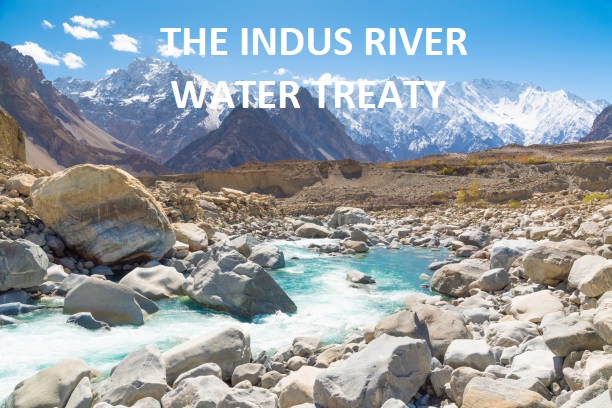Indus River Waters Treaty: History and Challenges
the Indus River Waters Treaty: The History and Challenges has long been considered one of the most effective water-sharing agreements in the world. India and Pakistan signed it in 1960. The World Bank acted as a mediator. The treaty allocated the eastern rivers—Ravi, Beas, and Sutlej—to India. It allocated the western rivers—Indus, Jhelum, and Chenab—to Pakistan. The agreement facilitated cooperation despite strained political relations.
Nonetheless, The Indus River Waters Treaty: Historical Context and Current Challenges has been under rising pressure in the last few years. Climate change has impacted the availability of water. Water demand in both countries has risen. Political tensions too have risen. Hydroelectric projects have caused conflicts, creating friction. Charges of violation of treaties have complicated things further.
Since both nations are confronting increasing environmental and strategic challenges, The Indus River Waters Treaty: Historical Context and Current Challenges remains to challenge their diplomatic skills and trust towards each other.
Indus River Waters Treaty: History and Challenges
A Brief Overview On The Indus Waters Treaty:
Facilitated by the World Bank and signed in 1960, the Indus Waters Treaty allocated the six rivers of the Indus Basin between India and Pakistan:
Eastern Rivers (Ravi, Beas, Sutlej) went to India.
Western Rivers (Indus, Jhelum, Chenab) went to Pakistan, with limited non-consumptive use (like for hydropower and irrigation) permitted to India.
The treaty also created a Permanent Indus Commission (PIC) to deal with conflicts and facilitate communication.
In spite of several wars and long–standing tensions, the IWT has withstood the test of time and is widely considered a rare example of India-Pakistan cooperation.
Opportunities in Water Resource Management
1. Peace and Stability Framework
The IWT has served as a safety net during strained times, keeping water problems from escalating to open conflict.
Even in the 1965, 1971, and 1999 wars, the treaty held.
2. Structured Dialogue Mechanism
Frequent PIC meetings give both nations a forum to exchange information.
If required, both the countries can debate on the projects, and resolve technical disputes diplomatically.
3. Scope for Sustainable Development
India may utilize Western rivers for run-of-the-river hydroelectric projects.
However, it can sustain renewable energy requirements without severely damaging Pakistan‘s entitlement.
4. Model for Transboundary Cooperation
The Indus River Water treaty can encourage such models in South and Central Asia.
It is possible because most rivers cut across political borders and trigger conflicts.
Indus River Waters Treaty: History and Challenges
Emerging Threats and Challenges
1. The Indus Waters Treaty and Climate Change
Climate change is a real threat to the Indus Waters Treaty through altering the supply and flow of river waters.
The melting glaciers, unpredictable rainfall, and repeated droughts are changing the quantity and timing of river discharge.
This alters the reliability of water distribution between India and Pakistan.
When water is scarcer and more unpredictable, there is more scope for conflict.
Himalayan glaciers that supply the Indus system are melting very fast, and monsoon variability is on the rise.
This interferes with seasonal water flow, impacting agriculture and water supply for drinking.
Climate change is therefore becoming a prime test of the long-term viability of the Indus Waters Treaty.
2. The Indus Waters Treaty and Infrastructure Disputes
Disputes over infrastructure, especially over hydroelectric installations, have emerged as a principal challenge to the Indus Waters Treaty.
India‘s development of dams and power facilities on the western rivers has been a source of concern for Pakistan regarding declining water flow and treaty breaches.
While India asserts that these installations comply with treaty regulations, Pakistan frequently approaches international arbitration.
These disputes strain diplomatic relations and dislocate cooperative mechanisms.
Infrastructure tensions point to the limitations of the treaty in managing changing technical and political complexities between the two countries.
India‘s Kishanganga and Ratle schemes have been vehemently opposed by Pakistan, which is concerned that these would curtail river flows.
Arbitration processes have at times stalled, raising trust issues.
3. The Indus Waters Treaty and Geopolitical Tensions
Geopolitical tensions between Pakistan and India still put the Indus Waters Treaty in danger of becoming unstable.
Every now and then, military clashes, border clashes, and political distrust spill over into water issues.
Threats to revisit or suspend the treaty have been issued during periods of increased tension, adding to uncertainty.
These hostilities lower the inclination towards negotiations and cooperation.
As long as wider political tensions exist, governing water resources under the treaty will be a challenging and precarious endeavor.
Post-terror attacks like Uri (2016), India’s political rhetoric included hints at re-evaluating the treaty. While symbolic, such moves affect long-term trust and cooperation.
4. The Indus Waters Treaty and Outdated Provisions
The Indus Water Treaty of 1960 includes provisions that are no longer capable of fully coping with the reality of water management today.
When the treaty was signed, climatic change, sophisticated irrigation systems, and expanding urban water demands were not accounted for.
There are no facilities in the treaty to adjust to contemporary challenges and changing hydrological information.
The inflexibility hinders it from effectively addressing today’s disputes.
Revising or amending the treaty has become necessary to make it more applicable and functional in the context of today.
The treaty fails to account for groundwater, ecological flow, or climate resilience, and hence is less applicable in today‘s environmental context.
5. The Indus Waters Treaty and Population Pressure
High population growth rates in both Pakistan and India have greatly enhanced water demand, placing further pressure on the Indus River system.
Growing cities, agriculture, and industry need more water than ever.
This growing pressure makes it harder for competition over common resources, and therefore cooperation under the treaty becomes tougher.
With continued population growth, equitable management of water becomes even more critical.
Without modification to take into consideration these demographic shifts, the Indus Water Treaty can fail to fulfill future water demands.
Both nations face growing water stress due to booming populations, water-intensive agriculture, and industrialization.
__________________________________________________________________________________________________________________________
Indus River Waters Treaty: History and Challenges
What If India Breaks The Indus Waters Treaty?
If India withdraws from or violates the Indus Water Treaty, it would have serious political, environmental, and humanitarian implications.
Since the treaty allocates vital river waters between India and Pakistan, any Indian withdrawal or violation unilaterally might be interpreted by Pakistan as an act of aggression.
This might increase diplomatic tensions and potentially ignite wider conflict between the two nuclear neighbors.
Pakistan, relying extensively on the western rivers for irrigation and domestic water supplies, would experience drastic water shortages, compromising food security and livelihoods.
Internationally, it could tarnish India‘s image as a responsible regional power and could invite criticism or pressure from other global institutions and countries that attach importance to treaty-based cooperation.
It might also create a harmful precedent for other transboundary water treaties.
Thus, violating the treaty would not only disturb an age–old water-sharing agreement but potentially destabilize peace and cooperation in South Asia.
__________________________________________________________________________________________________________________________
Consequences Of Breaking The Treaty On Pakistan’s Economy
If India violates the Indus Water Treaty, Pakistan’s economy might face serious damage, particularly in agriculture and the energy sector.
Agriculture is one of the largest employers of people in Pakistan and contributes largely to its GDP and depends highly on the Indus River system for irrigation.
Cuts or interruptions in the water supply would result in crop loss, lowered food yields, and an increase in prices, increasing food insecurity and rural poverty.
These are the effects of India violating the Indus Water Treaty on Pakistan’s economy, in bullet form:
Collapse of Agriculture
The major crops such as wheat, rice, and cotton would fail due to inadequate irrigation.
Food security and rural employment would be greatly impacted.
Shortages in Energy
Lower water flow would affect hydropower plants, resulting in shortages of electricity.
Frequent power cuts may occur in industries and homes.
Slowdown of Industry
Water-intensive industries such as textiles, sugar, and chemicals would be impacted.
Export performance can suffer, increasing the trade deficit.
Inflation and Rising Prices
Food and essential goods shortages may lead to inflation.
Public discontent can increase with rising cost of living.
Increased Public Spending
Government might have to spend a lot on alternative water facilities.
Fiscal strain may rise, aggravating debt and budget deficits.
Social and Political Instability
Water shortage may result in internal unrest, protests, and political instability.
The pressure on the government to act fast and effectively can grow.
Indus River Waters Treaty: History and Challenges
Recent Events
In 2023, India officially sent Pakistan a notice calling to change the treaty due to procedural lags and an obsolescent conflict settlement system.
The World Bank re-opened arbitration between both nations, and there are hearings for the Kishanganga and Ratle schemes.
There‘s increasing argument within India for wielding water as a geopolitical force—albeit this risks going against global law and destabilizing the area even further.
Ecological and Environmental Issues
Dams disrupt sediment flow, which impacts downstream agriculture.
Groundwater and water pollution are not well regulated within the treaty.
Biodiversity and livelihoods are threatened by wetland loss and diminished flow to delta areas such as Sindh.
The Way Ahead: Reform or Renewal?
In order to remain effective, the IWT must have a forward-looking upgrade. Some options are:
Modernization Measures
Integrate climate change projections into water-sharing models.
Treat groundwater and pollution under treaty terms.
Employ satellite technology for real-time monitoring of water.
Improved Cooperation
Encourage collaborative research, flood forecasting, and river basin planning.
Establish a neutral regional water forum to help in arbitration and planning.
Legal Innovation
Consider creating a bilateral environmental protocol to complement the treaty.
Implement flexible water-sharing provisions for drought or flood years.
Indus River Waters Treaty: History and Challenges
Conclusion:
To conclude, the Indus Waters Treaty is more than just a water-sharing agreement. It’s a symbol of cooperation amid adversity. But like the rivers it governs, it must adapt to new realities. It evolves into a stronger, more resilient instrument or fades under the pressure of 21st-century challenges. All will depend on the political will, technological innovation, and trust-building between India and Pakistan.
The Indus Water Treaty is an outstanding example of enduring cooperation between two arch-nemesis countries, India and Pakistan. In spite of decades of war and political hostility. It was signed in 1960 with the assistance of the World Bank and has managed to govern the distribution of river waters for more than six decades. Yet, new stresses like climate change, population explosion, out-of-date provisions, infrastructure conflicts, and geopolitical strife now challenge its applicability and durability. Even though the treaty has survived,
its survival remains contingent on how willing both nations are to reinvent, speak, and protect water as an interspecies, life-giving resource and not a political card. Strengthening the treaty by using contemporary mechanisms and cooperative trust-building is critical to avoid conflict and provide water security in the region. With increasing water scarcity, the Indus Waters Treaty needs to adapt to the changing realities of the 21st century.
In the face of a shared water future, collaboration is no longer an option—it’s a necessity.





0 Comments